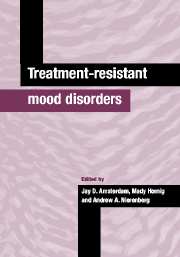Book contents
- Frontmatter
- Contents
- List of contributors
- Preface
- Part I The clinical problem
- Part II Biological basis
- Part III Treatment approaches
- Part IV Special patient populations
- 14 Chronic and refractory mood disorders in childhood and adolescence
- 15 Treatment-resistant depression in the elderly
- 16 Management of treatment-resistant depression during pregnancy and the postpartum period
- 17 Preliminary algorithms for treatment-resistant bipolar depression
- 18 Medical disorders and treatment-resistant depression
- 19 Psychiatric comorbidity in treatment-resistant depression
- 20 Suicide in treatment-refractory depression
- Part V Economic and ethical issues
- Index
- Plate Section
14 - Chronic and refractory mood disorders in childhood and adolescence
from Part IV - Special patient populations
Published online by Cambridge University Press: 25 March 2010
- Frontmatter
- Contents
- List of contributors
- Preface
- Part I The clinical problem
- Part II Biological basis
- Part III Treatment approaches
- Part IV Special patient populations
- 14 Chronic and refractory mood disorders in childhood and adolescence
- 15 Treatment-resistant depression in the elderly
- 16 Management of treatment-resistant depression during pregnancy and the postpartum period
- 17 Preliminary algorithms for treatment-resistant bipolar depression
- 18 Medical disorders and treatment-resistant depression
- 19 Psychiatric comorbidity in treatment-resistant depression
- 20 Suicide in treatment-refractory depression
- Part V Economic and ethical issues
- Index
- Plate Section
Summary
Introduction
Because the study of pharmacologic and non-pharmacologic treatments of childhood depression is several decades behind that of depression occurring later in the lifespan, the definition of ‘refractory depression’ needs to be modified for the pediatric age group in accordance with this dearth of scientific data (Geller et al., 1996). At the present time there is only one double-blind placebo-controlled study published that establishes superiority of active vs. placebo medication for children and adolescents (Emslie et al., 1997). That study used Xuoxetine. Six recent double-blind placebo-controlled studies examining various TCAs using DSM-III or higher diagnoses to characterize subjects were all negative. Based on the above, it can be argued currently that all childhood and adolescent depression can be characterized as ‘refractory’ if the measurement used is scientific evidence of efficacious treatments.
Nevertheless, the severity and chronicity of child and adolescent depression necessitate interventions which at the moment, unfortunately, cannot be developmentally based and have to largely be extrapolated from work done at older age groups. The problem with extrapolation is that there are clear developmental diVerences in response to treatment such as the negative TCA studies (Birmaher, 1998; Geller et al., 1999a); neurobiological diVerences in sleep parameters (Emslie et al., 1994; Dahl et al., 1996; Rao et al., 1996); cortisol metabolism (Puig-Antich et al., 1989) and heart rate variability (Walsh et al., 1994); and in the clinical picture which includes fewer and less prominent vegetative signs with decreasing age (Ryan et al., 1987). Further evidence of developmental differences appear in side effect profiles.
Keywords
- Type
- Chapter
- Information
- Treatment-Resistant Mood Disorders , pp. 273 - 287Publisher: Cambridge University PressPrint publication year: 2001
- 2
- Cited by



